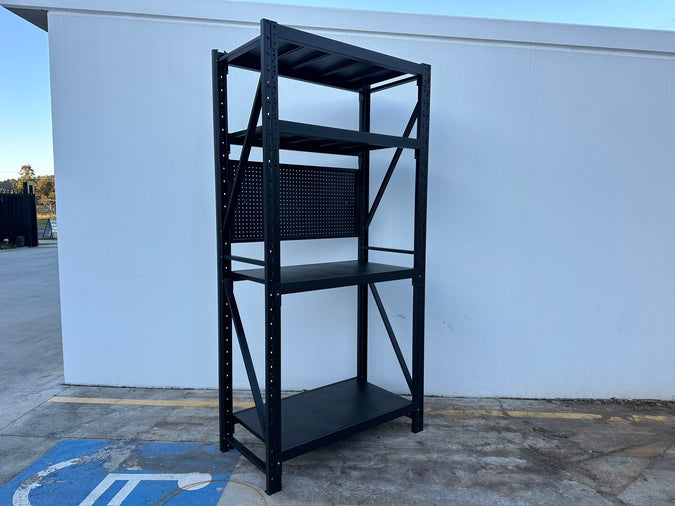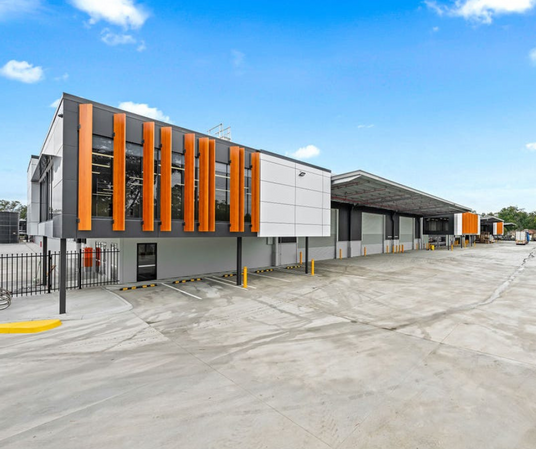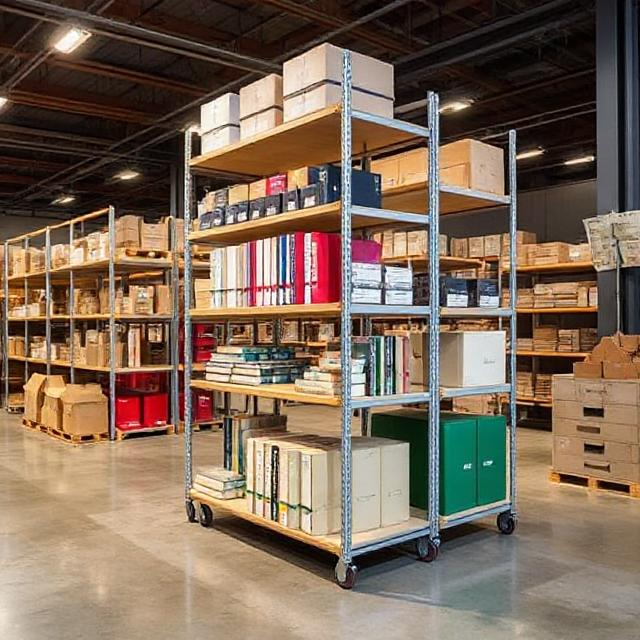In any warehousing or storage facility, maximizing space and organization is crucial. One of the most effective ways to do this is by utilizing shelving systems. Shelving is not just about stacking goods—it's about creating a system that optimizes space, improves accessibility, and enhances operational efficiency. In this article, we will explore what shelving in warehousing is, the types of shelving systems available, and how businesses can benefit from using high-quality shelving solutions.

Table of Contents
- Introduction to Shelving in Warehousing
- Why is Shelving Important in Warehousing?
- Types of Shelving Systems in Warehouses
- 1. Static Shelving
- 2. Mobile Shelving
- 3. Mezzanine Shelving
- 4. Racking Shelving
- Benefits of Using Shelving in Warehouses
- Steel Power Shelving: A Case Study
- Choosing the Right Shelving System for Your Warehouse
- Frequently Asked Questions (FAQ)
- Conclusion
Introduction to Shelving in Warehousing
Shelving in warehousing refers to the use of various types of storage systems designed to organize products and materials efficiently within a warehouse. These storage solutions help maximize vertical space, improve inventory management, and streamline the picking and storing processes.
The role of shelving in warehousing goes beyond just storing goods. It plays a key role in:
- Optimizing Space: Efficient shelving systems use available floor space more effectively by utilizing vertical space and providing easy access to products.
- Improving Organization: Shelving helps segregate items based on size, weight, or frequency of use, ensuring better organization.
- Boosting Productivity: Properly arranged shelving systems reduce the time spent searching for items, leading to faster picking and processing.
- Enhancing Safety: By securing items in designated spaces, shelving reduces the risk of products being damaged or causing safety hazards in the warehouse.
In this article, we will dive deeper into the different types of shelving systems and how they contribute to the smooth operation of warehouses.
Why is Shelving Important in Warehousing?
Shelving systems are critical for several reasons:
- Space Efficiency: Warehouses often have limited floor space, especially when dealing with large inventory volumes. By using shelving, businesses can utilize vertical space, thereby increasing the overall storage capacity.
- Inventory Control: Shelving allows for better organization of goods, which aids in stock rotation and easy tracking of inventory levels. This is essential for warehouses that manage multiple SKUs.
- Ease of Access: A well-designed shelving system makes it easier for warehouse workers to access products, reducing time spent searching for items and improving workflow efficiency.
- Safety and Protection: Proper shelving keeps products off the floor, reducing the risk of damage. It also creates a safer environment by preventing items from being stacked haphazardly.
- Cost-Effective: Shelving reduces the need for expensive storage equipment by providing a more affordable and scalable solution to increasing storage needs.
Overall, the right shelving system contributes to smoother operations, improved workflows, and significant cost savings in warehousing environments.
Types of Shelving Systems in Warehouses
There are several types of shelving systems used in warehouses. Choosing the right type depends on factors like the type of products being stored, available space, and the volume of inventory. Let’s explore the most common types of shelving systems in use today:
1. Static Shelving

Static shelving is the most common and traditional type of shelving used in warehouses. These systems consist of fixed shelves that remain stationary.
Key features:
- Simple Design: These are simple, stable units that hold goods in place.
- Fixed Structure: Shelves are stationary and do not move, making it ideal for items that do not require frequent access or rotation.
- Durability: Static shelves are typically made from materials like steel or wood, offering strong support for a wide range of items.
Ideal for: Light to medium-weight products, non-perishable goods, and those that are not frequently accessed.
2. Mobile Shelving

Mobile shelving systems are designed to move along tracks to maximize storage density. These shelves can be moved from side to side, creating aisles when needed and compacting storage when not in use.
Key features:
- Space Optimization: Mobile shelving increases storage space by reducing the need for wide aisles between shelves.
- Flexibility: Mobile shelves can be moved easily, providing adjustable layouts.
- Better Access: Only one aisle is needed at any time, allowing workers to access goods easily.
Ideal for: Warehouses with limited space, high-density storage needs, and large inventories.
3. Mezzanine Shelving

A mezzanine shelving system involves creating a raised platform within a warehouse, allowing additional shelving or storage space above the existing floor.
Key features:
- Vertical Expansion: This system effectively doubles storage space without requiring an expansion of the warehouse footprint.
- Customizable: Mezzanine shelves can be customized to accommodate different product sizes and warehouse needs.
- Efficient Use of Vertical Space: The system utilizes underutilized vertical space.
Ideal for: Warehouses with high ceilings or those looking to increase storage capacity without moving to a larger facility.
4. Racking Shelving

Racking shelving systems are typically used for heavy-duty storage. These systems consist of horizontal shelves supported by vertical frames.
Key features:
- Heavy-Duty Storage: Racks are ideal for storing large, bulky, or heavy items.
- High Load Capacity: Racking systems can hold substantial weights, making them suitable for bulk storage.
- Customization: Can be customized with different shelf materials and designs based on specific storage needs.
Ideal for: Large warehouses that handle heavy equipment, pallets, or bulk goods.
Benefits of Using Shelving in Warehouses
The use of shelving systems in warehouses provides a wide range of benefits:
1. Increased Storage Capacity
Shelving systems help maximize storage space by utilizing vertical space. This is particularly important in warehouses with limited floor area. High-density shelving systems like mobile shelving or mezzanine shelving can significantly increase storage capacity without the need for expansion.
2. Improved Workflow Efficiency
A well-organized shelving system ensures that products are easy to locate, retrieve, and store. This minimizes the time spent searching for items, improving inventory control and speeding up order fulfillment.
3. Enhanced Product Safety
Shelving systems keep products off the floor, reducing the risk of damage from moisture or accidents. It also helps keep the warehouse organized and reduces clutter, preventing hazardous situations.
4. Cost-Effective Solution
Shelving is a cost-effective way to increase storage capacity. It provides more storage space at a lower cost than other solutions, like warehouse expansion. By optimizing space, companies can store more products in the same area, reducing the need for additional warehouse space.
5. Flexible and Scalable
Shelving systems can be customized and scaled to fit the needs of any warehouse. Whether you need a system for small items or large, heavy products, there’s a shelving solution that fits.
Steel Power Shelving: A Case Study

One of the leading shelving suppliers in Australia is Steel Power Shelving. Based in Brisbane, Steel Power Shelving is known for providing durable and versatile storage solutions. Their products include:
- Shelf: Basic shelving units designed for general storage needs.
- Connecting Shelf: Shelving units designed to connect multiple units for enhanced organization and storage.
- Shelving with Pegboard: A customizable shelving system that features pegboards, ideal for hanging smaller tools or items.
Steel Power Shelving stands out due to its focus on high-quality materials and personalized customer care. They offer robust after-sales support and have a local delivery team to ensure smooth installation.
Choosing the Right Shelving System for Your Warehouse
Selecting the right shelving system for your warehouse depends on several factors:
- Product Type: Consider the size, weight, and nature of your products.
- Available Space: Look at your warehouse's layout and determine how much space you can dedicate to shelving.
- Budget: While shelving systems are generally cost-effective, some advanced systems like mobile or mezzanine shelving can be more expensive.
- Frequency of Access: If items need to be accessed frequently, systems with easy access and good organization should be prioritized.
Frequently Asked Questions (FAQ)
1. What is the difference between static and mobile shelving?
Static shelving is stationary and provides fixed storage, while mobile shelving can be moved to create more compact storage or wider aisles as needed.
2. How much weight can a racking shelving system support?
Racking systems are designed for heavy-duty storage and can support significant weight. Depending on the design and materials used, racking shelves can hold hundreds to thousands of kilograms per shelf
.
3. Can shelving systems be customized?
Yes, shelving systems can be customized in terms of size, material, color, and design to meet the specific needs of a warehouse.
Conclusion
Shelving is an integral part of warehouse operations. It helps maximize storage space, streamline workflows, and improve organization and safety. Whether you're using basic static shelving or advanced mobile shelving systems, the right shelving solution can enhance warehouse efficiency, making it an essential investment for businesses of all sizes.
For high-quality and customizable shelving solutions, consider Steel Power Shelving for durable products and reliable service.

